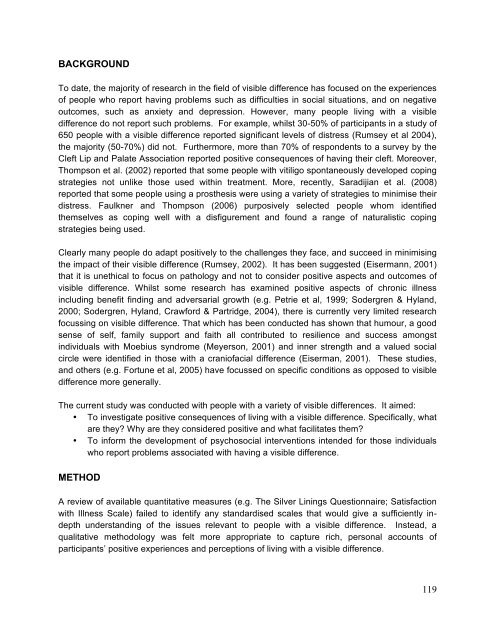Download the report - The Healing Foundation
Download the report - The Healing Foundation
Download the report - The Healing Foundation
Create successful ePaper yourself
Turn your PDF publications into a flip-book with our unique Google optimized e-Paper software.
BACKGROUND<br />
To date, <strong>the</strong> majority of research in <strong>the</strong> field of visible difference has focused on <strong>the</strong> experiences<br />
of people who <strong>report</strong> having problems such as difficulties in social situations, and on negative<br />
outcomes, such as anxiety and depression. However, many people living with a visible<br />
difference do not <strong>report</strong> such problems. For example, whilst 30-50% of participants in a study of<br />
650 people with a visible difference <strong>report</strong>ed significant levels of distress (Rumsey et al 2004),<br />
<strong>the</strong> majority (50-70%) did not. Fur<strong>the</strong>rmore, more than 70% of respondents to a survey by <strong>the</strong><br />
Cleft Lip and Palate Association <strong>report</strong>ed positive consequences of having <strong>the</strong>ir cleft. Moreover,<br />
Thompson et al. (2002) <strong>report</strong>ed that some people with vitiligo spontaneously developed coping<br />
strategies not unlike those used within treatment. More, recently, Saradijian et al. (2008)<br />
<strong>report</strong>ed that some people using a pros<strong>the</strong>sis were using a variety of strategies to minimise <strong>the</strong>ir<br />
distress. Faulkner and Thompson (2006) purposively selected people whom identified<br />
<strong>the</strong>mselves as coping well with a disfigurement and found a range of naturalistic coping<br />
strategies being used.<br />
Clearly many people do adapt positively to <strong>the</strong> challenges <strong>the</strong>y face, and succeed in minimising<br />
<strong>the</strong> impact of <strong>the</strong>ir visible difference (Rumsey, 2002). It has been suggested (Eisermann, 2001)<br />
that it is unethical to focus on pathology and not to consider positive aspects and outcomes of<br />
visible difference. Whilst some research has examined positive aspects of chronic illness<br />
including benefit finding and adversarial growth (e.g. Petrie et al, 1999; Sodergren & Hyland,<br />
2000; Sodergren, Hyland, Crawford & Partridge, 2004), <strong>the</strong>re is currently very limited research<br />
focussing on visible difference. That which has been conducted has shown that humour, a good<br />
sense of self, family support and faith all contributed to resilience and success amongst<br />
individuals with Moebius syndrome (Meyerson, 2001) and inner strength and a valued social<br />
circle were identified in those with a craniofacial difference (Eiserman, 2001). <strong>The</strong>se studies,<br />
and o<strong>the</strong>rs (e.g. Fortune et al, 2005) have focussed on specific conditions as opposed to visible<br />
difference more generally.<br />
<strong>The</strong> current study was conducted with people with a variety of visible differences. It aimed:<br />
• To investigate positive consequences of living with a visible difference. Specifically, what<br />
are <strong>the</strong>y? Why are <strong>the</strong>y considered positive and what facilitates <strong>the</strong>m?<br />
• To inform <strong>the</strong> development of psychosocial interventions intended for those individuals<br />
who <strong>report</strong> problems associated with having a visible difference.<br />
METHOD<br />
A review of available quantitative measures (e.g. <strong>The</strong> Silver Linings Questionnaire; Satisfaction<br />
with Illness Scale) failed to identify any standardised scales that would give a sufficiently indepth<br />
understanding of <strong>the</strong> issues relevant to people with a visible difference. Instead, a<br />
qualitative methodology was felt more appropriate to capture rich, personal accounts of<br />
participants’ positive experiences and perceptions of living with a visible difference.<br />
119


